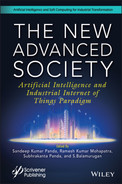13
An Investigation into COVID-19 Pandemic in India
Shubhangi V. Urkude1*, Vijaykumar R. Urkude2, S. Vairachilai3 and Sandeep Kumar Panda4
1ICFAI Business School, ICFAI Foundation for Higher Education, Hyderabad, India
2Vignan’s Institute of Management and Technology for Women, Hyderabad, India
3CVR College of Engineering, Hyderabad, India
4IcfaiTech, ICFAI Foundation for Higher Education, Hyderabad, India
Abstract
Pandemic of Coronavirus Disease (COVID-19) has put tremendous pressure on the people of different localities, states and countries. In a short span of time, it spread all over the world. This has affected the social life of people by enforcing them to stay at home and keep social distance. Many developed countries were also not able to handle the situation even though all resources were available with them. This chapter discussed about the symptoms of COVID-19, precautionary measures, ways of spreading the Coronavirus, and technologies used to fight COVID-19. This also discussed about the impact of COVID-19 on business, financial market, supply side, demand side and international trade on Indian economy.
Keywords: Corona virus, pandemic, financial market, COVID-19, symptoms
13.1 Introduction
COVID-19 is an acronym for Coronavirus Disease-19. This belongs to the large family of virus. It is caused due to severe acute respiratory syndrome. This kind of virus causes normal cold to the most chronic diseases like Middle East Respiratory Syndrome Coronavirus (MERS-CoV) and Severe Acute Respiratory Syndrome Coronavirus (SARS-CoV). It was first reported on December 31, 2019 in Wuhan, capital of Hubei, China. The outbreak of the epidemic started from the wholesale market of Wuhan which is famous for all kinds of rare live animals like snake, rat, crocodile, dog and so on. Sohrabi et al. [4] summarized the outbreak of coronavirus in United Kingdom (UK) and Britain. They studied the characteristics of coronavirus, preventive measures, diagnosis for the symptoms, kind of treatment given to the affected person, and the consequences of COVID-19. As per the survey conducted by the Centers for Disease Control and Prevention (CDC), the effect of coronavirus is more aggressive on older people of age greater than sixty years and children of age less than seven years. Adults having some chronic diseases like diabetes, heart disease, asthma, and kidney problems will be affected more.
The outbreak of COVID-19 came into picture on January 30, 2020, when the 1st positive case was detected in Kerala. The affected person had a travel history of returning from Wuhan. The 2nd and 3rd cases were also found in Kerala on February 2–3, 2020 and had similar travel history. Due to this, the Prime Minister announced ‘Janta Curfew’ of 14 h on March 22 in India. Figure 13.1 shows the timeline of the COVID-19 pandemic in India. The motive behind the Janta Curfew was to stop the spread of the virus. In this curfew time, people should stay in their home, all shops & transport should be closed except the essentials like medical shop and ambulance. Due to this, touching the contaminated object by the people from outside and the virus spread was avoided. The World Health Organization (WHO) mentioned that COVID-19 stayed alive on different surfaces for 7 to 12 h. With iron surfaces such as lift door and grills, it can live up to 12 h and the virus is transmitted to the healthy person who touches the lift door. On any wet object, it is alive up to 7 to 8 h. The first lockdown was announced in India on March 24 for 21 days. In this period only emergency services were open such as grocery shop and medical shop. The second lockdown was announced by the Prime Minister on March 20 with special guidelines for contaminated zones. The 3rd lockdown was declared on May 4 with different guidelines. The districts in the different states were divided into three different zones such as red, green, and orange zones. These zones were divided based on the number of active cases present in each district. In the red zone, only essential services were opened. In the orange zone, all shops were also open up to 1 pm along with essential services but transport is restricted whereas all shop will be kept open from 7 in the morning to 7 in the evening, in the green zone. Inter district transport was also open with 50% of the vehicle capacity and intra district permission was restricted.

Figure 13.1 Timeline of COVID-19 pandemic in India.
The 4th lockdown was declared on May 17 by the Prime Minister, in which cities/villages were categorized into red, green and orange zones depending on the number of positive cases in particular cities/villages. This decision was taken so as the other people who were living in the non-contaminated zone will not be affected. During this lockdown period of 71 days, there was a huge downfall in the Gross Domestic Product (GDP) of India. Because of the unavailability of transport, the prices of all products increased. The people of all the categories suffered but more precisely the farmers and below poverty line people were more affected. Farmers were not getting the reasonable price for their crops. Due to shutting down of most of the hotels, restaurants, cinema halls, public places, the daily workers were unable to fulfill their daily needs because the production in many private companies was stopped. To overcome all these problems, the government decided to remove the restriction slowly and started to unlock.
The first unlock was announced on June 1 with specific guidelines in each zone. The interstate and intrastate transport was started. All other services also started with specific guidelines depending on the service. Government and private offices also opened with 50% staffs and workers. The 2nd unlock was announced on July 1, with some more relaxed guidelines. As per these guidelines, educational institution, international travel, metro service, and public places remained closed. Domestic flights, online learning, inter and intra state transport of goods and persons were allowed. In the contaminated zone lockdown continued till July 31, entry and exit in this region were restricted, time to time contact tracing and clinical surveillance were done in this area. Everyone should wear face mask, keep social distance in public places, events were conducted with permission of less than 50 peoples, last rituals with permission of 20 people, washing of hands on a regular basis, work from home, and consumption of toxic materials was prohibited [15]. The 3rd phase of unlock was announced on August 1, 2020.
13.1.1 Symptoms of COVID-19
The primary symptoms include dry cough, sore throat, high fever and difficulty in breathing. Figure 13.2 shows the primary symptoms of COVID-19. According to the World Health Organization (WHO), the pandemic COVID-19 had three types of symptoms which were mainly More Common Symptoms, Uncommon Symptoms and Rare Symptoms.
Table 13.1 shows the summary of COVID 19 symptoms that were collected from the official website of WHO [14]. These symptoms are finalized by the WHO after performing collaborative study with China. In China, a total of 55,924 confirmed cases were examined; where most of the cases were having fever, dry cough, fatigue, and sputum production. Generally, COVID-19 cases develop symptoms after 5–6 days of infection. Very few cases were having shortage of breath, sore throat, headache, chills and arthralgia. The 80% of the confirmed cases of Coronavirus have moderate disease like pneumonia and other small disease, 13.8% cases diagnosed with severe disease like breathing problem and few of them 6.1% are diagnosed with critical problems like respiratory failure, multiple organ failure. Approximately 0.1% cases were asymptomatic and symptoms were visible after some period of time [5].
13.1.2 Precautionary Measures
A major cause of spreading the virus is the direct contact of living and non-living contaminated objects. Figure 13.3 shows the precautionary measures taken to prevent the outbreak of COVID-19. Every individual should follow the following precautionary measures:
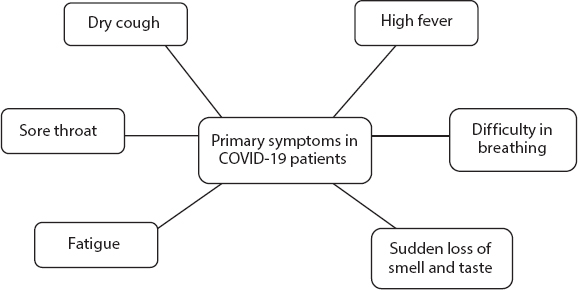
Figure 13.2 Primary symptoms of COVID-19.
Table 13.1 Summary of COVID 19 symptoms.
| Symptoms | Percentage |
| More Common Symptoms | |
| Fever | 87.9% |
| Dry Cough | 67.7% |
| Fatigue | 38.1% |
| Sputum Production | 33.4% |
| Uncommon Symptoms | |
| Shortness of Breath | 18.6% |
| Myalgia/Arthralgia | 14.8% |
| Sore Throat | 13.9% |
| Headache | 13.6% |
| Chills | 11.4% |
| Rare Symptoms | |
| Nausea | 5.0% |
| Nasal Congestion | 4.8% |
| Diarrhea | 3.7% |
| Hemoptysis (coughing up blood) | 0.9% |
| Conjunctival Congestion | 0.8% |
- Cover the mouth with cloth, handkerchief or tissue while coughing and sneezing.
- Wash the hands regularly with alcohol-based sanitizer or soap and water.
- Avoid unnecessary contact with anyone and stay away from sick person.
- Do not touch the face frequently without cleaning.
- Use mask while going out and disposed it properly in a closed dustbin [6].
- Avoid community gathering and keep social distance.
- Stay home and stay safe.
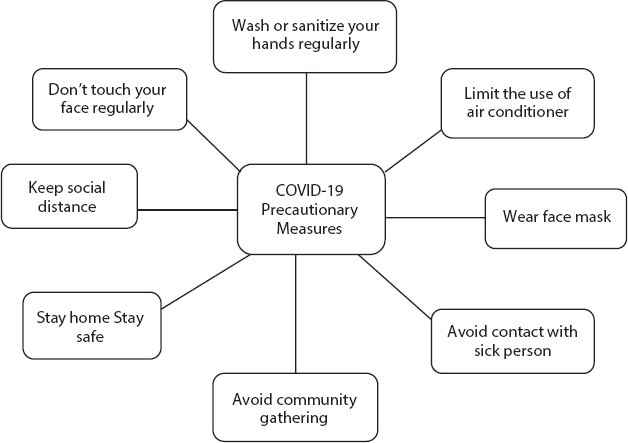
Figure 13.3 Precautionary measures for spreading of COVID-19.
- Limit the use of air conditioners in the offices and public gathering.
13.1.3 Ways of Spreading the Coronavirus
As per the Indian Medical Association (IMA) report, the number of cases is gradually increasing in India that leads into community spread of virus. Virus is spreading inside the town and villages in the dense locality. After unlock 2.0 was announced by the Prime Minister, many governments and private sectors started working and the employees had to travel to their workplaces.
For transportation, most of the people in India depend on public transport and social distancing is not followed in those cases. That resulted to the virus is spreading at a faster rate and positive cases were increasing twice apart from the existing cases. Some of the main reasons of the spread of the virus are shown in Figure 13.4. A major reason for the outbreak of coronavirus was contact with an infected person. Some of the reasons for spreading the virus are listed below:
- Virus droplets are spread into air when an infected person coughs or sneezes.
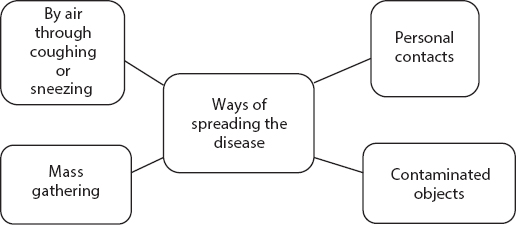
Figure 13.4 Different ways of spreading the coronavirus.
- Virus will spread through personal contact with others.
- Touching a contaminated object with an open hand and touching the face or any other thing without washing the hands lead to spreading of the disease.
- In most cases the virus will spread in mass gathering.
13.2 Literature Survey
Sear et al. [7] discussed about machine learning model for interpreting health conditions during COVID 19. They explained that the impact of particular vaccination is less focused than the pro-vaccination community. The anti-vaccination community is for better than the pro-vaccination community for tracking the ongoing COVID 19 pandemics. Gharizadeh et al. [8] reviewed clinical aspects of molecular tests and immunoassays in managing the virus life cycle in various phases like preventive phase, preparedness phase, response phase, and recovery phase. They reviewed nucleic acid test that was carried out at home using new technologies like Clustered Regularly Interspaced Short Palindromic Repeats (CRISPR) diagnostics, Visual end point detection and PCR (Polymerase Chain Reaction) free method to upgrade public health infrastructure to come out of this pandemic outbreak of COVID 19 in the future. Nadeem [9] reviewed many sources that were open to provide literature for pandemic. The American Chemical Society (ACS) gives many articles that discussed about spreading of infectious diseases and their outbreak in different environmental situations. Semantic scholar published an open dataset and scholarly articles on COVID 19 for researchers. The World Health Organization (WHO) released an open database that includes dataset and relevant scientific articles. As per the article published in the Elsevier website, infections vary from without any symptoms like fever, cough, and dyspnea to deadly symptoms like respiratory tract infection including some uncommon symptoms like sore throat, and rhinorrhea [10]. In the WHO report, the Department of Biotechnology introduced a vaccine named ZyCoV-D is in the phase I/II of its clinical trial. This vaccine was tested on multiple animal species like rats, rabbits, mice, and guinea pigs. After testing the species gave strong immune response.
The Department of Biotechnology is modifying the vaccine in the forthcoming weeks even after the virus mutates to the current environmental condition, it is able to provide the protection [12]. The Ministry of Health and Family Welfare (MoHFW) decided to add health chapter separately in the 15th Finance Commission Report to the government. Currently, 35 and 65% public health expenditure is shared by central and state governments respectively. As per the National Health Policy (NHP) 2017, public health expenditure is 2.5% of GDP till 2025, primary health expenditure is 2/3 of total health expenditure and state sector is spending more than 8% of their current budget on health expenditure. The National Research Development Corporation (NRDC), Ministry of Science and Technology, Government of India and M/s Paulmech Infrastructure Pvt. Ltd. Kolkata made an agreement to transfer control technologies developed by the S N Bose National Research Center for Basics Sciences (SNBNCBS). These COVID control technologies are an Active Respirator with Attached Exhalation Valve and Suspended Particulate Matter Filter for Comfortable and Hygienic Breathing and Long-Lasting Nano-Sanitizer with a Dispensing Antimicrobial Layer [12].
13.3 Technologies Used to Fight COVID-19
13.3.1 Robots
A Jaipur-based company developed the first robot in the world using spine technology. These robots are used to check if the person is wearing a mask or not and thermal scanning. Jaipur hospitals are using robots to carry food and medicine to isolation wards.
Robots are used in shopping malls for sanitization using Ultra Violet (UV) light technology. Milagrow imap9 and Humanoid ELF are two robots used in AIIMS (All India Institute of Medical Science) hospital in Delhi to assist doctors in COVID-19 wards. This robot’s height is 92 cm. This can perform various functions like recording activities, remote communication between the patient and doctor, and communication with patient’s family.
In Bengaluru, Fortis hospital is using robots at the entrance to scan the medical staff and others while entering into the hospital. A Jaipur based company developed the first robot in the world using spine technology. These robots are used in thermal scanning, identifying the person is wearing mask or not. Jaipur hospitals are using robots to carry food and medicine to isolation wards.
In Kerala, three wheeled robots developed by Asimov robotics are used to help health care workers in the isolation ward. These robots are used to give medicine to patients, serve food and assist them in various activities. This avoids the infections of health care workers [16].
13.3.2 Drone Technology
The drone technology was used to overcome the outbreak of COVID-19 pandemic. Drones can function 50 times faster than humans and are able to reach inside the inaccessible areas. These drones are designed using the technologies like data analytics, Artificial Intelligence (AI), and Internet of Things (IoT). In India, various drone companies came forward to overcome this pandemic. The Garuda Aerospace in Chennai supplied 300 drones across 26 cities, Marute drone in collaboration with T-Hub and IIIT-Hyderabad (International Institute of Information Technology) and RICH (Research and Innovation Circle of Hyderabad) produced drones that are used by the Telangana government to disinfect water bodies. The Ministry of Civil Aviation (MoCA) and Directorate General of Civil Aviation (DGCA) launched the GARUD (Government Authorization for Relief Using Drones) portal to fight with the outbreak of COVID-19. The certain features of drones such as vertical takeoff and landing capability (VTOL), Beyond Visual Line of Sight (BVLOS), cost effectiveness and portability make them suitable to use in these extreme conditions.
13.3.3 Crowd Surveillance
In the period of pandemic of COVID-19, drone technology became a more powerful tool to monitor different crowed areas in India such as the slum area of Dharavi in Mumbai, Maharashtra [1]. Dharavi is Asia’s biggest slum spread over 520 acres and having a population of about 700,000. It has a highly dense population of 2,77,136/km2. Because of the dense population it is difficult to keep surveillance inside the slum area. The Delhi slum area is also using drone for crowd surveillance. Ghaziabad, Delhi, and Gujarat police are using drones to ensure social distancing among people, to make public announcement, and to create awareness in the public. According to the Drone Federation of India (DFI), 450 to 500 drones are used across India to fight against the COVID-19 outbreak. Many industries like Quidich Innovation labs, AutoMicroUAS, Aarav, and Asteria Aerospace are the part of DFI.
13.3.4 Spraying the Disinfectant
A drone is controlled remotely and is able to reach inside the small lanes in the slum area, congested places where the human cannot enter and spray disinfectant. Drones are used effectively to spray disinfectant in the contaminated areas, which will reduce the human workers’ direct contact and increase speed of work. In India, drones are used to spray disinfectant in contaminated zone, shopping malls, and airports, etc. Agra is using agricultural drones to spray alcohol-based disinfectant in the affected areas. Human can carry 10 L of disinfectant only 4 to 5 km per day but drones can carry over 20 km per day.
13.3.5 Sanitizing the Contaminated Areas
During sanitization, there is a possibility of coming in contact with virus, so drones can be used to perform sanitization in contaminated zones.
13.3.6 Monitoring Temperature Using Thermal Camera
In the airport, drones can be equipped with thermal camera to check the body temperature of the passengers.
13.3.7 Delivering Essential Things
Drones are used in different states such as Kerala, Delhi to supply essential products like medicines and sanitizer in contaminated areas. It is able to carry around 10 kg weights for 1 km and used to supply food items in contaminated areas. In India, drones are deployed in Guwahati, Assam, Sangli and Maharashtra to survey public places.
13.3.8 Public Announcement in the Infected Areas
Drones are used to drones to make public announcement in the crowed places such as Rayatu bazaar and to make awareness among the people.
13.4 Impact of COVID-19 on Business
India is a developing country. During the lockdown, COVID-19 had affected all the businesses in India. All the big and small businesses were shut down and thousands of labors working in those industries became unemployed. As per the census 2011, migration of workers was 41.42 million but now this increased exponentially. Due to the extension of lock-down, the Government had announced some relaxation to the poor people. Many companies developed digital platforms such as Zoom, Google Meet and Microsoft team for virtual learning, taking on line classes, conducting video conference, etc. In India, these digital platforms are used by the student and faculty community. The Zoom application profit increased 78% and Google Meet application profit increased 60% [2]. Gardner et al. [11] discussed in the business review the benefit of remote working of employees in the pandemic situation. Many companies are adopting digital transformation of their workplaces to work remotely. They discussed about employees work tension who are all working in multiple projects and mapping their skills and capacity. According to a business survey, Indian businesses are at a high risk and many businesses are trying to reduce the manpower because of the unavailability of funds to pay their salaries. As per the survey done by the FICCI (The Federation of Indian Chambers of Commerce and Industry) on March 20, 2020, many business sectors in India were affected [13] and are discussed below.
13.4.1 Impact on Financial Markets
Due to the extremely volatile condition of financial markets many businesses are having huge crashes and destruction, impacting the consumption level. As per FICCI report, global equity markets like the BSE (Bombay Stock Exchange) Sensex and NSE (National Stock Exchange) Nifty prices crash more than 8% in a day. This is the biggest day fall and nearly 10 lakh crores wiped off. This fall continues due to rising cases of coronavirus in the country. At the time of closing Sensex closed at 28,288 falling 581 points and Nifty fell 205 points and closed at 8,263. This volatile nature will continue in the future and there is huge loss of investors due to the COVID 19 pandemic outbreak.
13.4.2 Impact on Supply Side
Many Indian manufacturing companies are closed due to lack of intermediate products from China. Many factories such as automobile, electronics, pharmaceuticals, chemical product are closed because of shortage of raw materials and other components. There is huge impact on the export chain of India because of the reduced production in other parts of the world like Asia, Europe, and the US.
13.4.3 Impact on Demand Side
The business-like hospitality, aviation, and tourism are the most affected sectors in this pandemic outbreak. The shutting down of the shopping malls, hotels, restaurants and cinema theaters affected the retail sector.
13.4.4 Impact on International Trade
India is the biggest market for most of the Chinese products. Similarly, Indian products like seafood, petrochemicals, gems, and jewelries are exported to other countries are reduced. Between February and April 2020 business in Jaipur lost 8,000–10,000 crore because of the cancellation of major events in the foreign countries.
13.5 Impact of COVID-19 on Indian Economy
COVID-19 had badly affected the Indian economy. In the financial year 2020, the Gross Domestic Product (GDP) of India fell down to 4.0%, which is the same as seven years before. This is due to the reduced prices of crude oil in the international market, recession throughout the world, no funds through tax, any transport and tourism, etc. Due to the pandemic outbreak, Industrial sectors, Entertainment sectors and Tourism & Travel sectors are affected. Indian historical places are always an attraction for the people living in the foreign countries. As per the report given by Indian Association of Tour Operators (IATO), India lost up to 8,500 crores due to ban on foreign tourists. Many national wide events were cancelled due to the nationwide lockdown and many blue-collared workers’ jobs in risk. The Events and Entertainment Management Association (EEMA) reported that 60 million of their workers are affected due to COVID-19 [3].
13.6 Data and Result Analysis
Figure 13.5 shows the position of India in terms of number of positive cases in the world [18]. In this chart, x-axis represents the name of countries and y-axis represents the total number of confirmed cases in terms of millions. This data is collected from the WHO website up to July 31, 2020 [18]. As per statistics report, India is in the third position. In Figure 13.5, the United States has 43, 88,566 confirmed cases, Brazil has 25, 52,265 confirmed cases and India has 16, 38,870 confirmed cases. In India 27.19% of the confirmed cases are present as compared to the US. Due to the shortage of hospitals, beds, ventilators and health care workers the US government is unable to handle this situation. The Indian government is able to provide medical assistance to 80% of the patients admitted in hospitals.
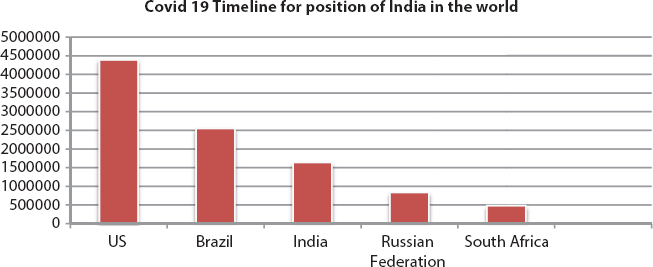
Figure 13.5 COVID 19 timeline for top five countries in the world.
Figure 13.6 shows the top fifteen cities in India in terms of number of confirmed cases in the pandemic outbreak. In this chart, x-axis represents the name of cities in India and the y-axis represents the total number of confirmed cases in thousands. This data was collected from the WHO website up to July 31, 2020 [18].
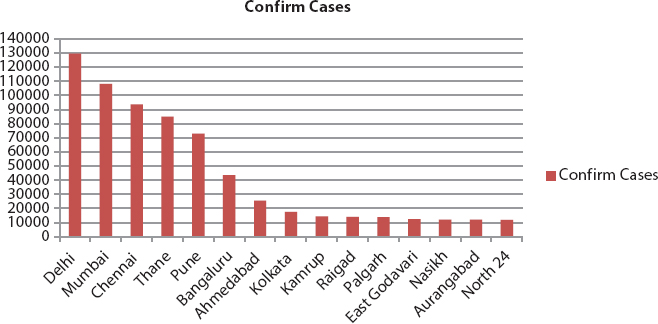
Figure 13.6 Number of active COVID 19 cases in top 10 cities in India.
The data required for doing analysis is collected from the official website of Government of India [17]. The data consists of six attributes and 36 records. The attributes are state, total/confirm cases, recovered/discharged cases, death cases, date and time of collecting the data. This data shows number of active cases, recovered cases, and death cases in all 28 states and eight union territories in India. Figure 13.7 shows the total number of active, recovered, and death cases in India as of July 31, 2020.
In this chart, x-axis represents the states in India and y-axis represents the total number of confirmed recovered and active cases in thousand scales. In this chart, Maharashtra has the highest number of active cases and recovered cases and the recovery rate of Maharashtra is 60%. Tamil Nadu is the 2nd state in terms of number COVID cases present. Lakshadweep is the only one region away from the coronavirus pandemic. In Kerala, the recovery rate is more than the number of people affected due to pandemic.
Figure 13.8 shows the number of recovered cases in India. In this chart x-axis represents the states in India and y-axis represents the total number of recovered cases in thousand scales. As per the analysis report, Mizoram has zero death cases and recovery rate is nearly 52% of the total number of cases. The recovery rate of Ladakha is nearly 80%. The highest number of COVID 19 cases is in Maharashtra with a recovery rate of 36% of the total cases.
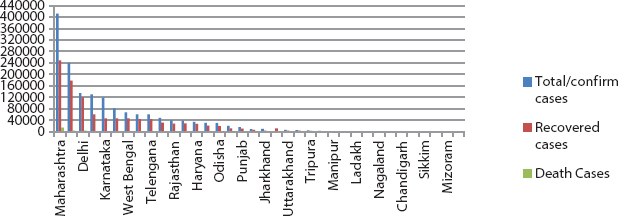
Figure 13.7 State wise number of active, recovered and death cases in India.
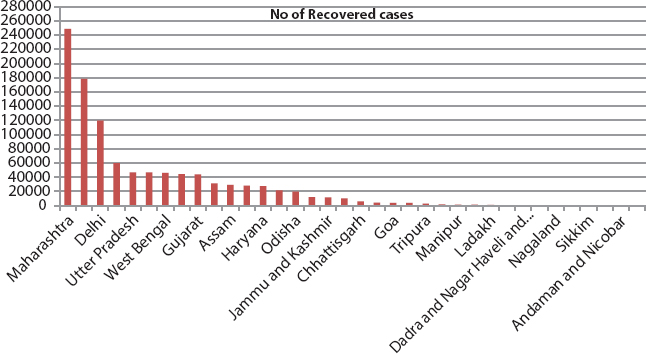
Figure 13.8 Number of recovered cases in India.
Figure 13.9 shows the number of death cases in India. In this chart x-axis represents states in India and y-axis represents total number of death cases in thousand scales. As per analysis, death rate in Maharashtra is 0.021% of the total cases found.

Figure 13.9 Number of death cases in India.
13.7 Conclusion and Future Scope
Coronavirus is the largest pandemic ever seen in the world till now. It affected the normal lifestyle of every person in the world. Due to this outbreak of COVID-19, many technologies are used to control the pandemic such as drones, robots, etc.
Many startup companies growing their businesses and many teaching learning platforms are developed. It impacted most of the other businesses in the India such as tourism, poultry, aviation, financial sectors, etc. It affected the Indian economy very badly. Due to this pandemic India will take around 20 years to come back to the present situation. As per the analysis, almost all the states and union territories are affected by COVID-19. Maharashtra and Delhi are affected more and Lakshadweep is the only one union territory not affected by COVID 19 pandemic outbreak. This work can further extend to predict COVID-19 in India depending on the number of past history cases using Machine Learning algorithms in the future.
References
1. Crowed surveillance in the slum area, 2020, Wikipedia, Available online at https://en.wikipedia.org/wiki/Dharavi.
2. The Impact of COVID-19 on Consumers: Preparing for Digital Sales. IEEE Eng. Manage. Rev., 48, 212–218, 2020.
3. Impact on Indian Economy, 30 december, 2020, Nitin Sahi, BW Businessworld, Available online at: http://bwdisrupt.businessworld.in/article/Impact-of-COVID-19-on-Indian-Economy-and-Road-Ahead-for-Corporate-Sector-/30-04-2020-190322/.
4. Sohrabi, C., Alsafi, Z., O’Neill, N., Khan, M., Kerwan, A., Al-Jabir, A., Iosifidis, C., Agha, R., World Health Organization declares global emergency: A review of the 2019 novel coronavirus (COVID-19). Int. J. Surg., World Health Organization, U.S.A., 76, 71–76, 2020.
5. Report of the WHO–China Joint Mission on Coronavirus Disease 2019 (COVID-19), WHO, World Health Organization, U. S. A., Feb 2020, Available online at: https://www.who.int/docs/default-source/coronaviruse/who-china-joint-mission-on-covid-19-final-report.pdf.
6. World Health Organization, U.S.A, 1 December 2020, When and how to use masks, Available online at: https://www.who.int/emergencies/diseases/novel-coronavirus-2019/advice-for-public/when-and-how-to-use-masks.
7. Sear, R.F., Velásquez, N., Leahy, R., Johnson Restrepo, N., El Oud, S., Gabriel, N., Lupu, Y., Johnson, N.F., Quantifying COVID-19 content in the online health opinion war using machine learning. IEEE Access, 8, 91886–91893, April 2020.
8. Gharizadeh, B., Yue, J., Yu, M., Liu, Y., Zhou, M., Lu, D., Zhang, J., Navigating the Pandemic Response Life Cycle: Molecular Diagnostics and Immunoassays in the Context of COVID-19 Management. IEEE Rev. Biomed. Eng., 1–19, 2020.
9. Nadeem, S., Coronavirus Covid-19: Available Free Literature Provided by Various Companies, Journals and Organizations Around The World Journal. J. Ongoing Chem. Res., 5, 1, 7–13, 2020.
10. Available online at: https://www.elsevier.com/__data/assets/pdf_file/0005/991418/COVID-19-_Ambulatory_2.1_OrderSets_070420.pdf
11. Gardner, H.K. and Matviak, I., Coronavirus Could Force Teams to Work Remotely. Harv. Bus. Rev., March 5, 2020, Available online at: https://hbr.org/2020/03/coronavirus-could-force-teams-to-work-remotely.
12. World Health Organization, U.S.A, 19 July 2020, The COVID-19 confirm cases data throughout the world, Available online at: https://www.who.int/docs/default-source/wrindia/situation-report/indiasituation-report-25.pdf?sfvrsn=8269893f_2.
13. Federation of Indian Chambers of Commerce and Industry, IMPACT OF COVID- IMPACT OF COVID-19 ON INDIAN ECONOMY, pp 1–21, March 20, 2020. FICCI, Available online at: http://ficci.in/spdocument/23195/Impact-of-COVID-19-on-Indian-Economy-FICCI-2003.pdf.
14. Government of India, India, July 2020. All the COVID related information, Available online at: https://www.mygov.in/covid-19/.
15. https://static.mygov.in/rest/s3fs-public/mygov_159357705551307401.pdf
16. Chamola, V., Hassija, V., Gupta, V., Guizani, M., A Comparehensive Review of the COVID-19 Pandemic and the Role of IoT, Drones, AI, Blockchain and 5G in managing its Impact. IEEE Acess, 8, 90225–90265, 2020.
17. Government of India, India, 2020, COVID-19 data for India, Available online at: https://data.gov.in/major-indicator/covid-19-india-data-source-mohfw.
18. World Health Organization, U.S.A., 2020, World Health Organization every day situation report, Available online at: https://covid19.who.int/.
*Corresponding author: [email protected]; ORCID: orcid.org/0000-0003-4062-1445
Vijaykumar R. Urkude: ORCID: orcid.org/0000-0002-5648-1646
S. Vairachilai: ORCID: orcid.org/0000-0002-8577-6195
Sandeep Kumar Panda: ORCID: orcid.org/0000-0002-0752-4267
